Chindogu are inventions that defy concise explanation. They aren't useful. But they aren't completely useless either. Their creator, Kenji Kawakami, describes them as "un-useless."
Perhaps the best way to understand chindogu is to see them in action:
Chindougu 珍道具 is made up of two words. Chin 珍 means "curious" or "strange." Dougu 道具 means "tool" or "device."
"Strange device" doesn't quite capture the entire meaning though. There's an essence to chindogu that can't be ignored. They need to be useful, but only just so. Something people could use, but probably won't because of shame.
They're almost useful. Or "unuseless."
10 Tenets of Chindogu
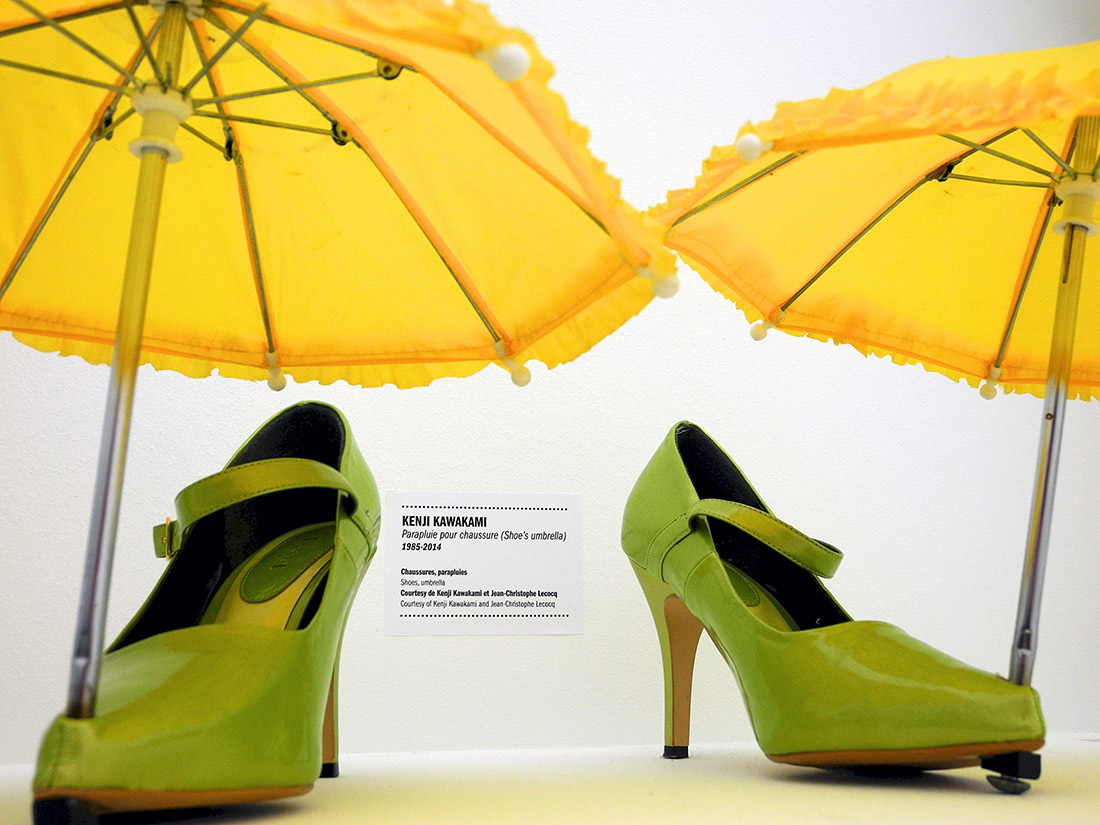
How can we distinguish real chindogu from the imitators? The device must adhere to the 10 tenets of chindogu set up by inventor Kenji Kawakami and the International Chindogu Society. Check out the society's official website for their wording of the tenets (which is sometimes unclear). This is our interpretation of the laws.
1. Chindogu must be (almost) completely useless
This is the utmost tenet. If your invention is a real help and you use it all the time, it's not chindogu. Try selling it to the public because it could be worth millions. Too bad it has no soul.
2. Chindogu must exist
Chindogu have to be made. If you design the invention on paper and don't make it, it doesn't qualify. It's a piece of paper with a bad invention on it. Bring the invention into the physical world so humankind can experience how truly almost useless it is.
3. Chindogu represent freedom of thought and action
Chindogu are free to be what they need to be. Normal devices are designed for efficiency, ease of use, and utility.
4. Chindogu's uselessness must be understood by all
If you create a device that is only recognized as useless by people with certain knowledge sets (doctors, mechanics, biologists, etc.) then it is not chindogu.
For example, if you make a useless invention intended to help with space shuttle operations, it would take a rocket scientist to distinguish it from useful space tools. Normal people must be able to recognize the uselessness immediately.
5. Chindogu are not for sale
If you accept money for your invention, it ceases to be chindogu. You have violated its spirit.
6. Humor must not be the sole reason for making chindogu
Any humor derived from chindogu is a side effect. The invention must earnestly try and solve a problem. The roundabout and unconventional way it solves the problem is the source of the humor.
7. Chindogu are not propaganda
They are made to be used, even though they are (almost) useless. They are not, in and of themselves, a statement for any cause or philosophy.
8. Chindogu are never taboo
Chindogu inventions cannot be made to enact or represent cheap sexual innuendo, vulgar humor, or sick jokes that disrespect living things.
9. Chindogu cannot be patented
The invention must remain in the public domain. It must be free to use, re-create, and distribute. It cannot be copyrighted or owned.
10. Chindogu are without prejudice
Chindogu view all human beings as equal. Therefore, they can't favor a race, religion, age group, gender, or class.
Chindogu Examples
With the 10 tenets fixed firmly in your heart, let's look at some examples of chindogu. From these you'll be able to clearly see each one at work.
Butter Stick
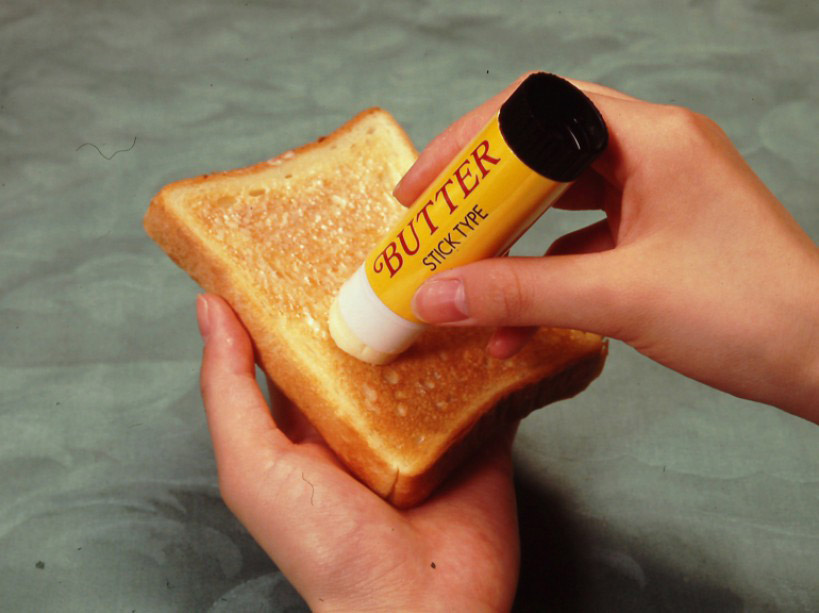
The butter stick is possibly the most well-known chindogu. Maybe because it's the one people could actually see themselves using (almost). When you don't have a knife or the time to butter toast, the Butter Stick is there for you. I wonder what other condiments could work in stick form…
360-Degree Camera Hat
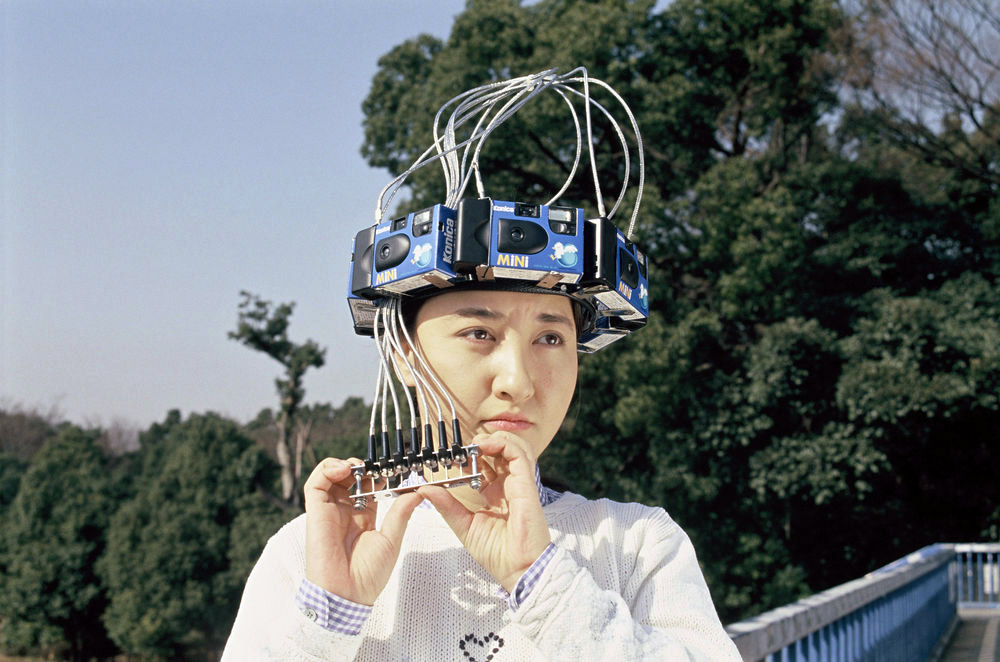
When you can't choose the best camera angle, choose them all. This invention is designed to create panoramic photos. Strap the Camera Hat to your head and snap the pictures. Get the pictures developed, tape them end-to-end in a circle, and stick your head inside.
Noodle Cooler

Sometimes ramen and udon1 are just too hot. That's why you slurp. But maybe that's not enough to keep the noodles from burning thy lips. Enter the noodle cooler. An electric fan cools your noodles before they get close to scalding your mouth.
Shoe Broom and Dustpan
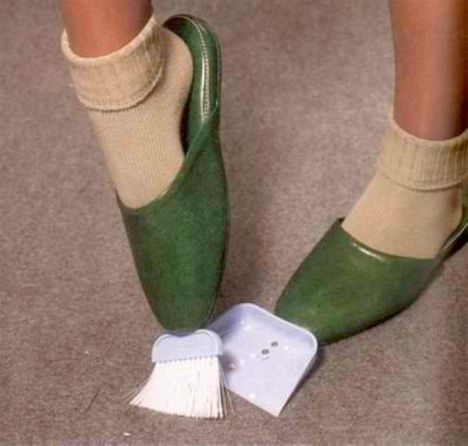
Getting the broom out of the closet for a small bit of dust is a real pain. And bending down to use a handheld broom can be difficult for the elderly and obese. That's when you slip these babies on. Use one foot to sweep and the other to collect. But then, how do you get your dustpan foot up to the trash can?
Lipstick Guide

Get the perfect lipstick application every time. Just strap on the lip stencil and go to town. This speeds up the lipstick process a lot. No more slow precision. Smear the lipstick all over the place and you're done. Efficient!
Umbrella Shoes
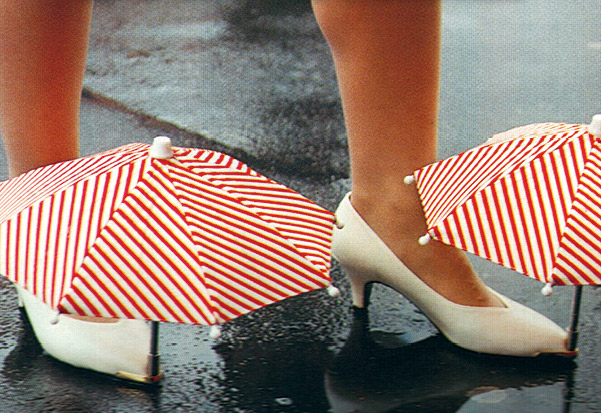
Stop letting dangerous waters pour all over your expensive shoes. This invention protects those Guccis and Air Jordans from inclement weather. Plus you don't have to worry about wet socks, which is the worst thing about rain.
Camera Umbrella

Whether you're in the splash zone at Sea World or a kitsune wedding, there are times you want to get wet and take pictures. This invention was made for such occasions. A tiny umbrella for your camera. Finally, you can take your $6000 Nikon camera to the water park! Just don't drop it in the Lazy River.
Back Scratch Guide
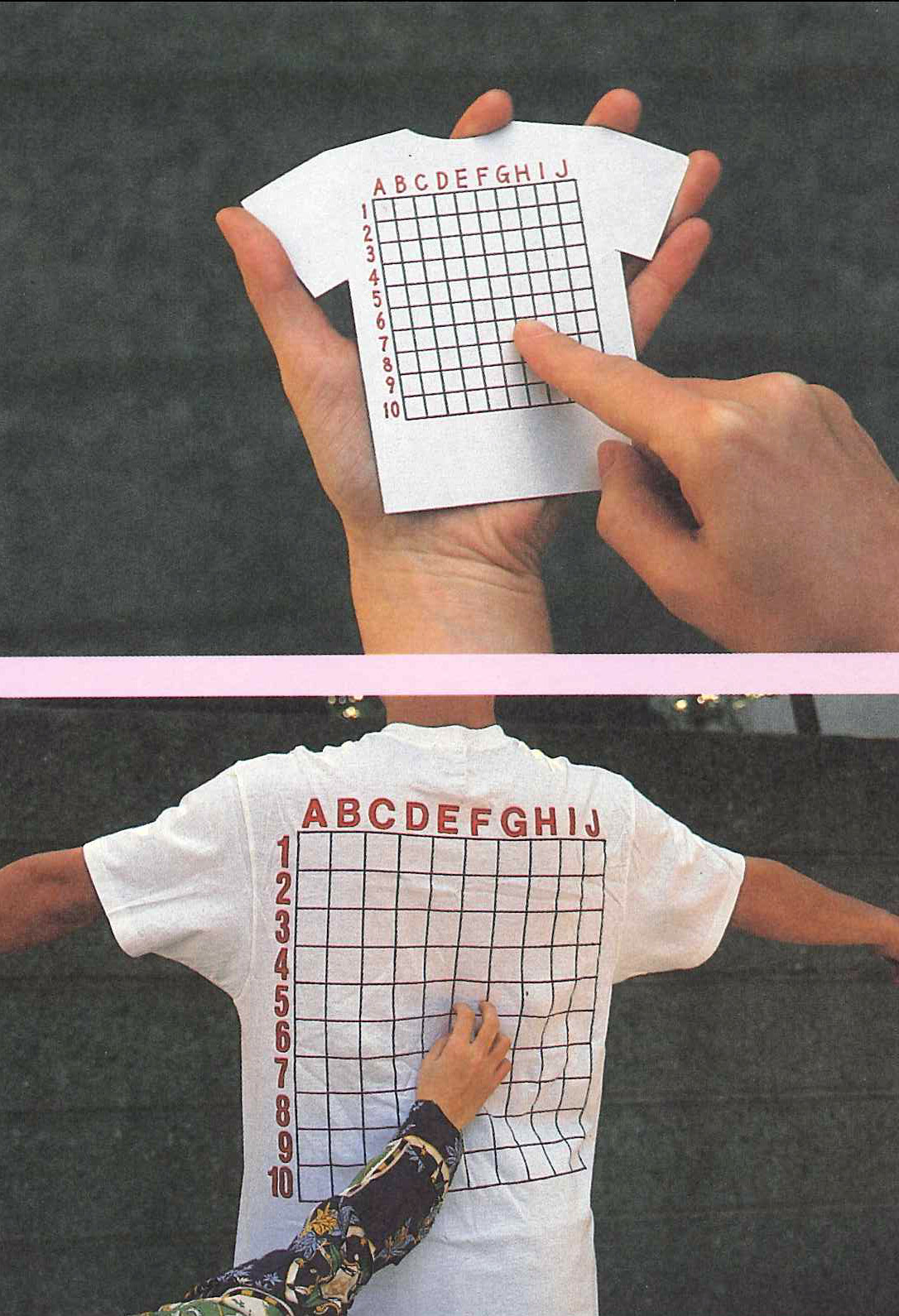
Telling friends where to scratch you can be a chore.
A little left. Up a little. No, back down.
Slip on this chindogu shirt and use the accompanying chart to identify the itchy area. Your scratch companion now knows the exact square to attack.
Hay Fever Headset

Keep tissues spooling toward your nose at all times.
You get a sneeze attack on a crowded bus! No problem. Reach up, pull down, and cover that sneeze.
Eyedrop Funnel Glasses
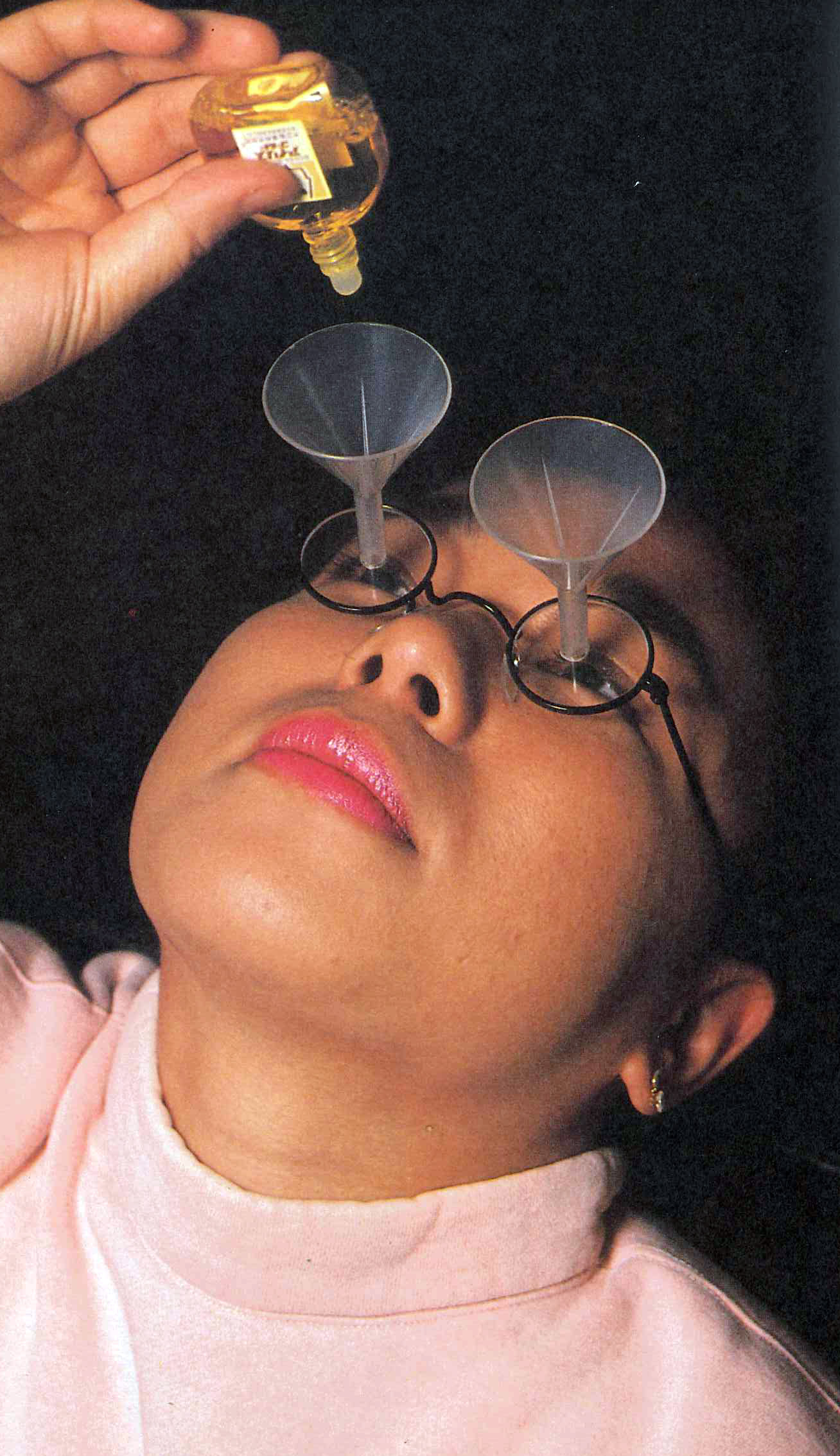
Sometimes your eyes need drops. You could hover the eyedropper above your peepers and hope for the best. But we know how that ends. 50% of that precious eye medicine goes on your cheeks. And you can't be wasting eye medicine like that. Not in today's economy.
Good thing you've got Eyedrop Funnel Glasses. Now, you can drop any liquid into your eyes with 100% accuracy.
Baby Mop (or Cat Mop)
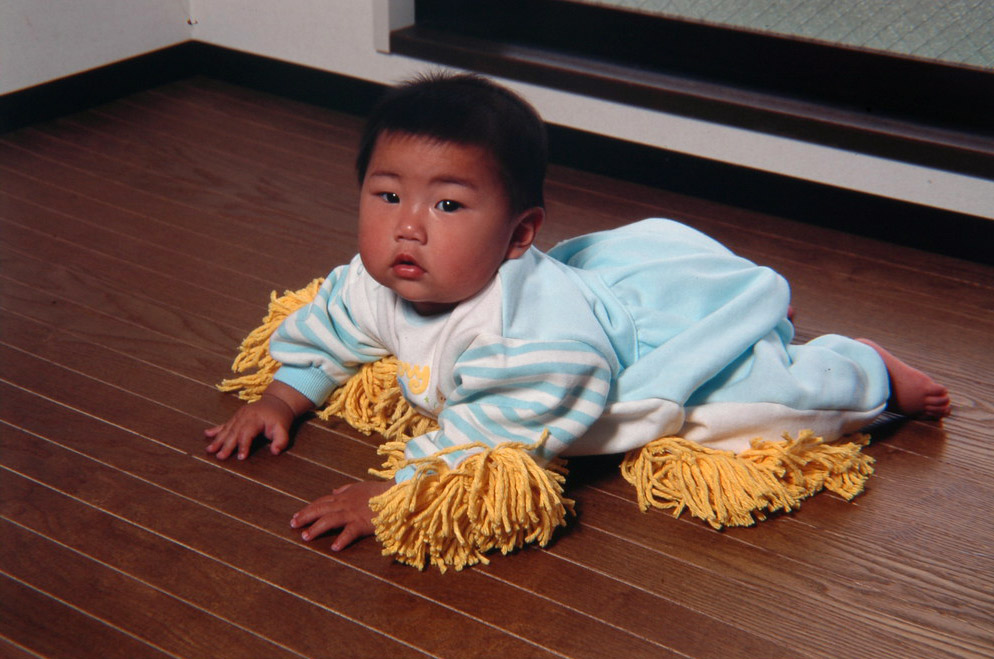
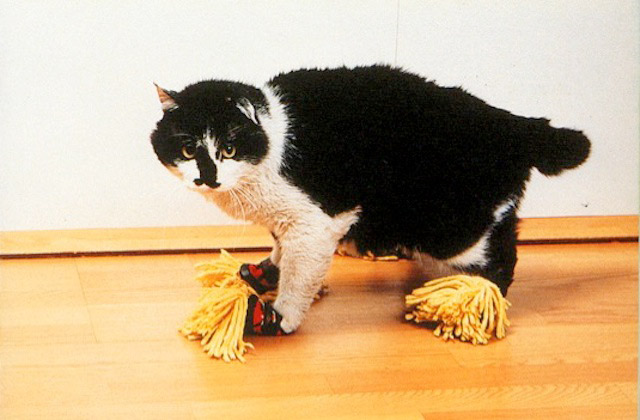
There's nothing lazier than babies and cats. Both need food and shelter, but offer nothing in return. Time to turn the tables on these miniature hobos. The baby mop and cat mop will transform your shiftless baby/cat into a useful cleaning machine.
You can actually buy the baby mop. Because chindogu by nature cannot be patented (tenet number 9), anyone can produce them. The unprincipled charlatans over at BetterThanPants sell a version of Kawakami's baby mop.
But be warned: if you buy this, you're not buying chindogu (see tenet number 5).
Swiss Army Gloves
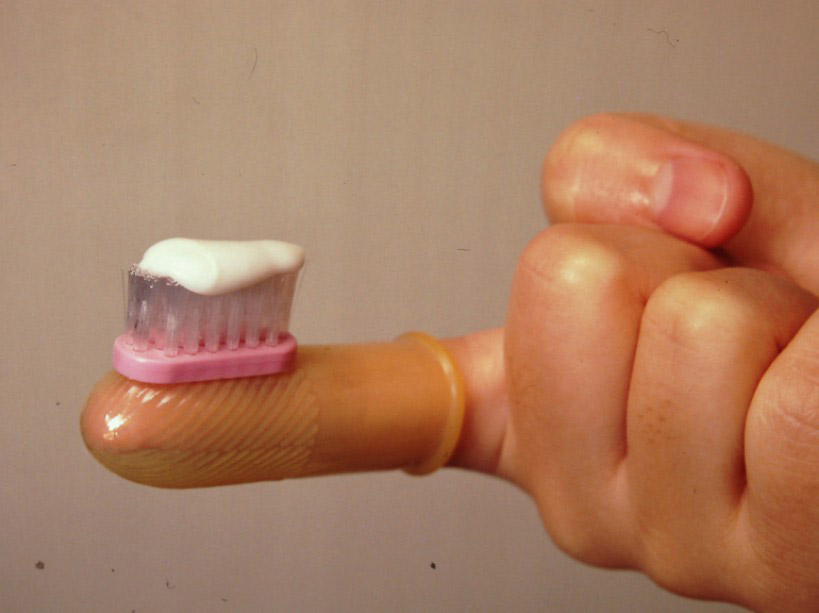
What is a toothbrush anyway? Some bristles on a stick. And what is your finger but a fleshy stick with bone in the middle? Why not cut out the stick middleman and just attach the bristles to your finger? You've just entered a whole new level of hamigaki).
Onion Chopping Glasses
Of all the chindogu inventions listed here, this is the one I could most see myself using. I hate getting onion pain in my eyes. It's the worst. Your eyes get watery, your vision gets blurry, and before you know it, you've chopped off a finger.
But you can chop onions pain free with this inventions. Little fans on either side of the glasses blow the onion fumes away from your eyes. The glasses themselves probably protect a little bit too.
Noodle Splash Guard
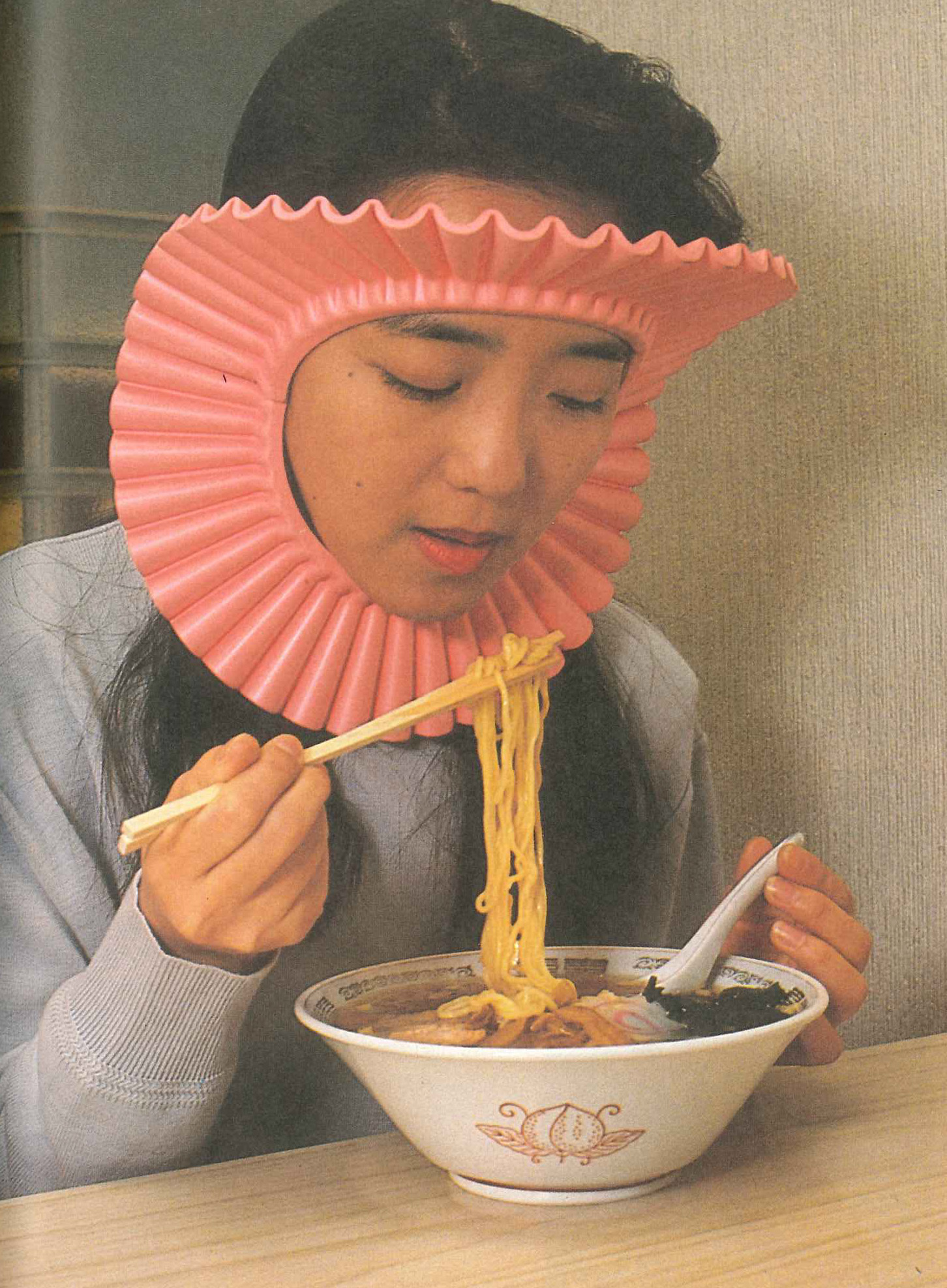
Eating ramen too fast will invariably get broth all over your precious, precious locks. Enter the Noodle Splash Guard, the invention that guards your hair from ramen or udon splash. Now you can eat with gusto!
Umbrella Tie

You're off to your high power job in Japan. You're wearing your high power suit. But the weather forecast calls for rain in the afternoon. You don't want to lower the power of your suit by carrying an umbrella. Especially when it's not raining. People will look at you and think "that guy or gal must be really low power."
This chindogu lets you wear your umbrella while retaining all the power you've stored up. When it starts to rain, you'll be the only salaryperson keeping dry, because those other low power fools didn't bring an umbrella.
Subway Sleeper
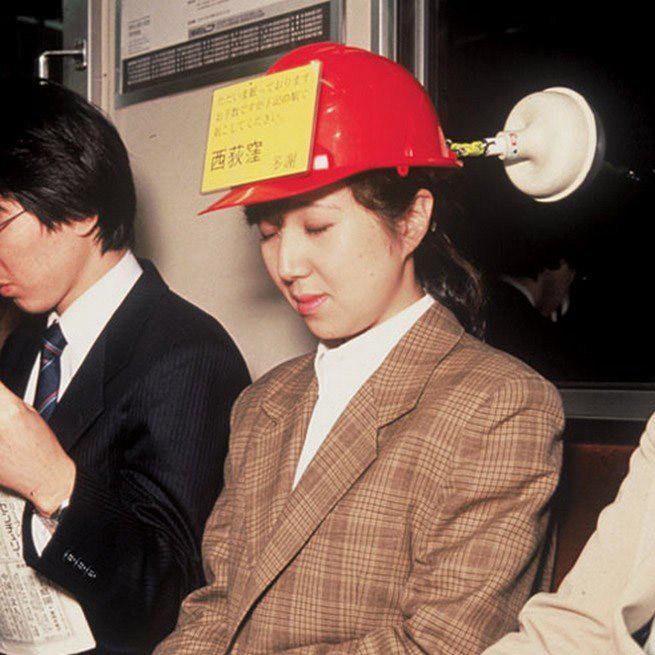
You've been working all day. Like a literal 24 hour day. It's time to go home. But you can't keep your eyes open during your train ride home. What if you fall asleep and miss your stop? You'll wake up in bumpkinville, that's what.
This is when you need the Subway Sleeper Hat. You can sleep without falling face first into the floor. Also, the handy sign on the hat tells other passengers what stop you're getting off at, so they'll know when to wake you.
The Selfie Stick

You read that right. Before it was sold in stores, the selfie stick was chindogu.
Kenji Kawakami came up with the idea while on vacation. He gave his camera to a child, asking them to take his picture. When he turned his back, the child ran away with the camera.
So he invented the "Self Portrait Camera Stick" in 1983. It was made and sold by Minolta but quickly failed. In 1995, he added it to his first chindogu book.
Wait a minute. If the chindogu selfie stick was created to be sold, then it's not real chindogu (tenet number 5). Sorry Kawakami-san. Those are the rules.
Chindogu History
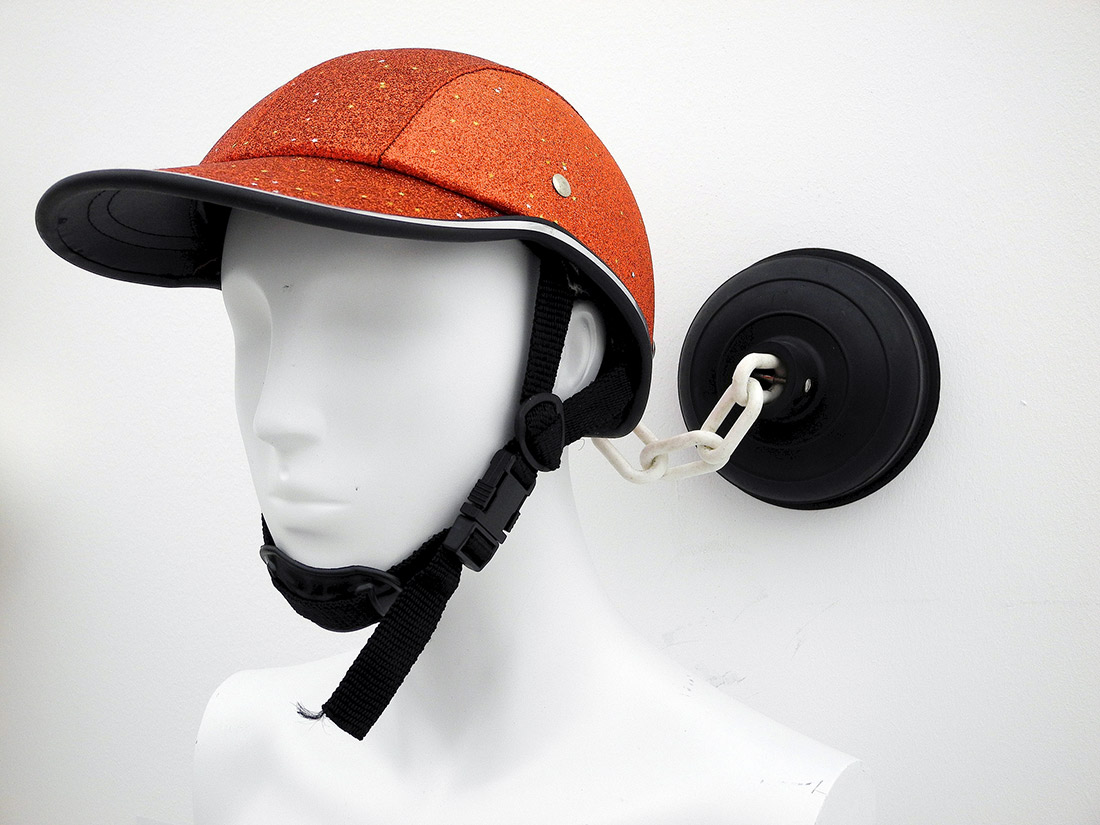
The story of chindogu is the story of one man, Kenji Kawakami. Kawakami was born in Nara prefecture in 1946. He studied aeronautical engineering at Tokai University in 1967 but dropped out when he got involved with student movements in the 1970s. Young Japanese college grads from the 60s became violently opposed to the ruling Japanese and American powers in the 1970s. Kawakami himself lobbed molotov cocktails at police. It was these days of radical thinking that eventually led to the philosophy behind chindogu.
But as the years wore on, activism began to splinter into smaller and smaller left wing sects which fought amongst themselves. By the 1980s, most Japanese activists entered lives in the system they had previously opposed. Kawakami took several jobs, mostly freelancing writing and editing. He even wound up writing scripts for the Japanese children's cartoon Calimero.
This eventually led him to a job as editor of a popular home shopping catalog, Tsuhan Seikatsu 通販生活. This is ironic considering how much he hates materialism. "I despise materialism and how everything is turned into a commodity," he once said. Maybe it was this irony, becoming something he hated, which drove him to create chindogu. He began making his "unuseless" inventions during his time at Tsuhan Seikatsu.
Chindogu would have remained an obscurity if he hadn't been working for the mail order catalog. As an editor, he was in charge of filling each page. One month, he had extra pages to fill.
Kawakami filled the empty pages with products that weren't for sale. The first was his eye drop funnel glasses (which he himself used). The second was a solar powered flashlight (which can only be used if you have enough light to power it). He dubbed these items "chindogu" and sent the catalogs out.
His inventions were an instant hit. Readers demanded more and Kawakami complied, inserting pictures of new inventions in each catalog. Before long he began getting invitations to art exhibitions, interviews, and TV shows.
Eighteen months later, chindogu caught the eye of Dan Papia, a writer for the English language magazine, the Tokyo Journal.2
Dan decided to write an article about Kawakami's gadgets, and thus the concept was introduced to the English speaking world. Readers loved it and Kawakami's inventions became a regular feature in the pages of the magazine.
It wasn't long before Tokyo Journal readers began sending their chindogu ideas to Dan. That's when it hit him. Dr. Kawakami shouldn't be the only one making these "unuseless" inventions. He believed it was a new art form and everyone should be allowed to participate.
In 1995, Dan founded the International Chindogu society along with Kenji Kawakami. They established rules for proper chindogu creation (the ten tenets listed above). That same year, he and Kawakami collaborated on the first chindogu book "101 Unuseless Japanese Inventions: The Art of Chindogu." They made another book "99 More Unuseless Japanese Inventions: The Art of Chindogu" in 1997.
From here chindogu took off. The International Chindogu Society began gaining members. Passionate advocates like Hugh Fearnley-Whittingstall introduced chindogu to new communities. Kenji Kawakami was invited for interviews and TV appearances outside of Japan. He became a regular fixture on the BBC's It'll Never Work? and Tomorrow's World. In Europe, he was seen as a genius artisan of the surreal. In the US, a wacky inventor. In Hong Kong, a potentially profitable innovator.
For all his fame, Kawakami has never made a yen off of his inventions (remember tenet number 1). He's never registered a patent and never will. He has said "Things that should belong to everyone are patented and turned into private property…the world of patents is dirty, full of greed and competition." In addition, he waives the speaker fees any time he gives a talk and donates any money he makes from books and articles to his favorite causes.
Kawakami never married and has no children. He pursues his dreams to the fullest and continues to hold exhibitions and work on his side businesses. He's shown no signs of slowing.
Chindogu are made to stimulate imagination, not profits, so Kawakami will likely continue creating chindogu until the end. "I think of chindogu as an intellectual game to stimulate anarchic minds," he's said "or a physical manifestation of my way of thinking."
His "way of thinking" was initially contagious. But does chindogu have the momentum to stand the test of time?
Chindogu's Spread and Decline
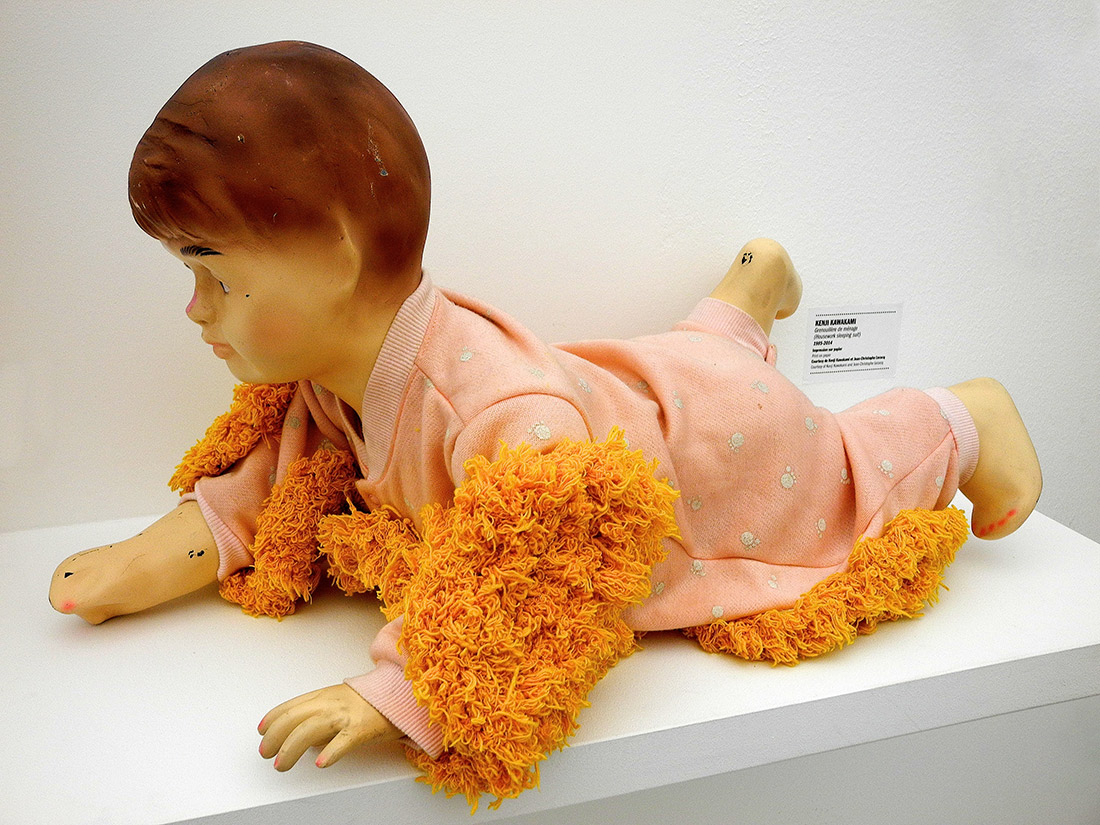
Since its rise in popularity in the mid-90s, chindogu has taken on a life of its own. Societies, clubs, and association were formed. Exhibits were held. Though chindogu activity still continues, it seems to have died down. Kawakami himself is still active, but as he ages, the future of chindogu is uncertain.
The Japanese Chindogu Society is still run by Kenji Kawakami, but the website is defunct. He's more of an analog guy anyway. Not much for the digital. "If you look at digital products, they all isolate people and leave them in their own small world, depriving them of the joy of communicating with others," he once said. "I can't deny that they make life more exciting and convenient, but they also make human relationships more shallow and superficial." This explains the astounding lack of Kawakami-driven chindogu info online.

He does things in the real world though. Kawakami exhibited his creations at Design Tide '07, a now-defunct design show in Tokyo. It was a pretty small exhibition from the looks of the video above.
In 2010, behind the scenes videos of a chindogu documentary appeared on YouTube.
The 9 videos, each about 15 seconds long, show Kawakami dressed as some kind of 18th century dandy. They were posted by the ChindoguSociety YouTube channel, which has zero subscribers as of this writing. As far as I can tell, the documentary was never completed. The same year, he appeared in an interview with ABC news.
These small blips of Kawakami activity, paired with his hate for the digital world, make me wonder if the idealistic inventor is still doing things and not publicizing them.
Dan Papia, the English translator of the chindogu books, is still the President of The International Chindogu Society. He founded the society in Los Angeles. The old version of the website is still up and running (for now). It paints a clear picture of chindogu's cult status in the late 90s. He is currently a professor at the Global Communications Arts Institute in Tokyo.
There may or may not have been several chindogu societies throughout the U.S., or perhaps the world. Some sources claim the International branch has "10,000 members.", but one has to wonder how and when that number was counted, and if it's still accurate. Nevertheless, there is one piece of evidence that proves there was a chindogu society in Milwaukee, WI at one point. The video below, shows the society's chindogu competition from 2007.
Though America's fascination with chindogu is (mostly) gone, France's love is alive and well. The Chindogu Association of France may not have a website, but they did put together a book called "The 10 Commandments of Chindogu"
Kawakami exhibited chindogu at the Foire Internationale de Marseille in 2013 and 2014. Footage of the 2013 exhibition can be seen in the video above.
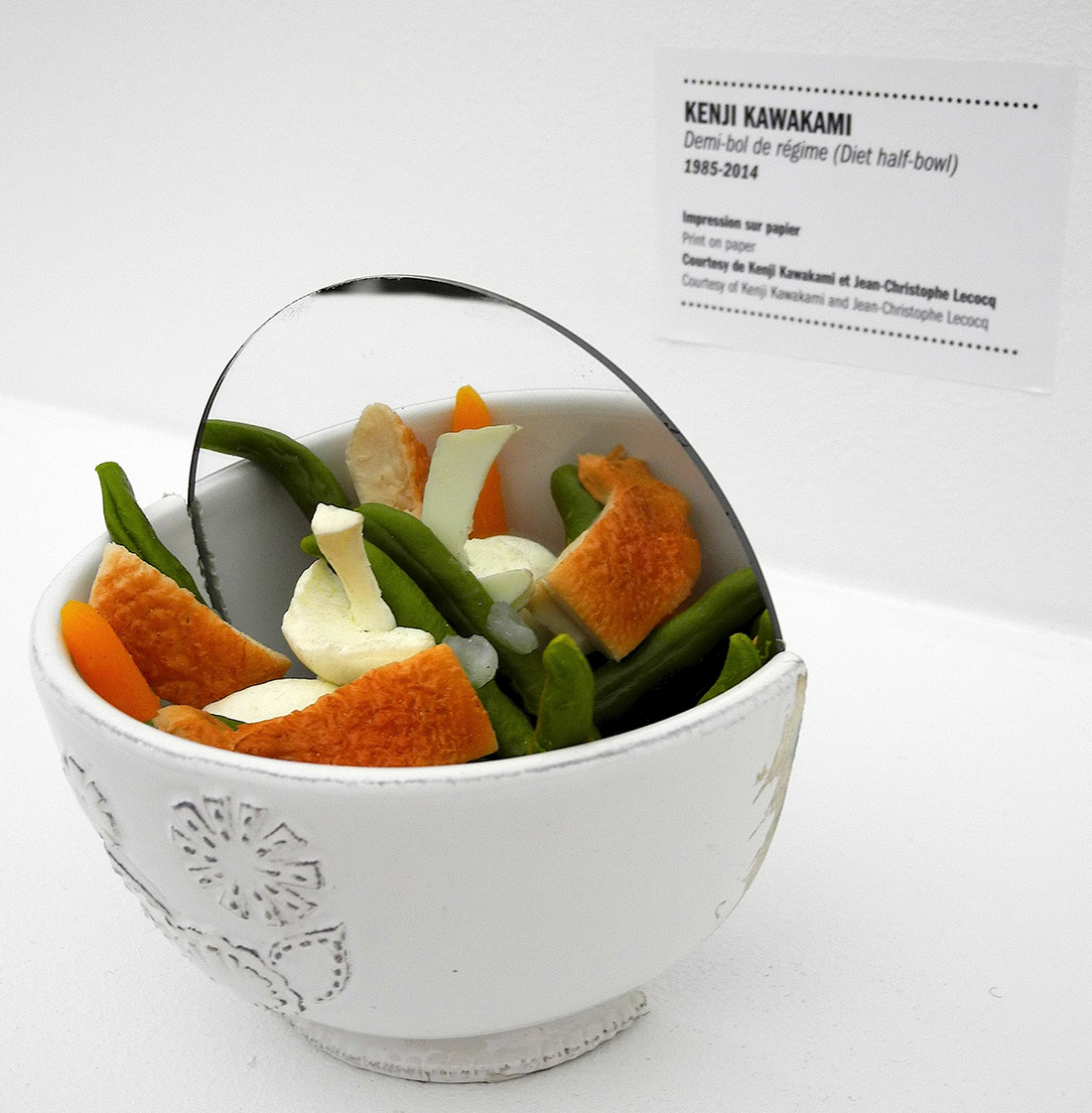
The yearly Paris fair, Foire D'Automne, featured a chindogu exhibit in 2016 as well. The Paris art museum, Palais de Tokyo, featured Kawakami photos and inventions as works of art in 2015.
Is Chindogu Worth Preserving?
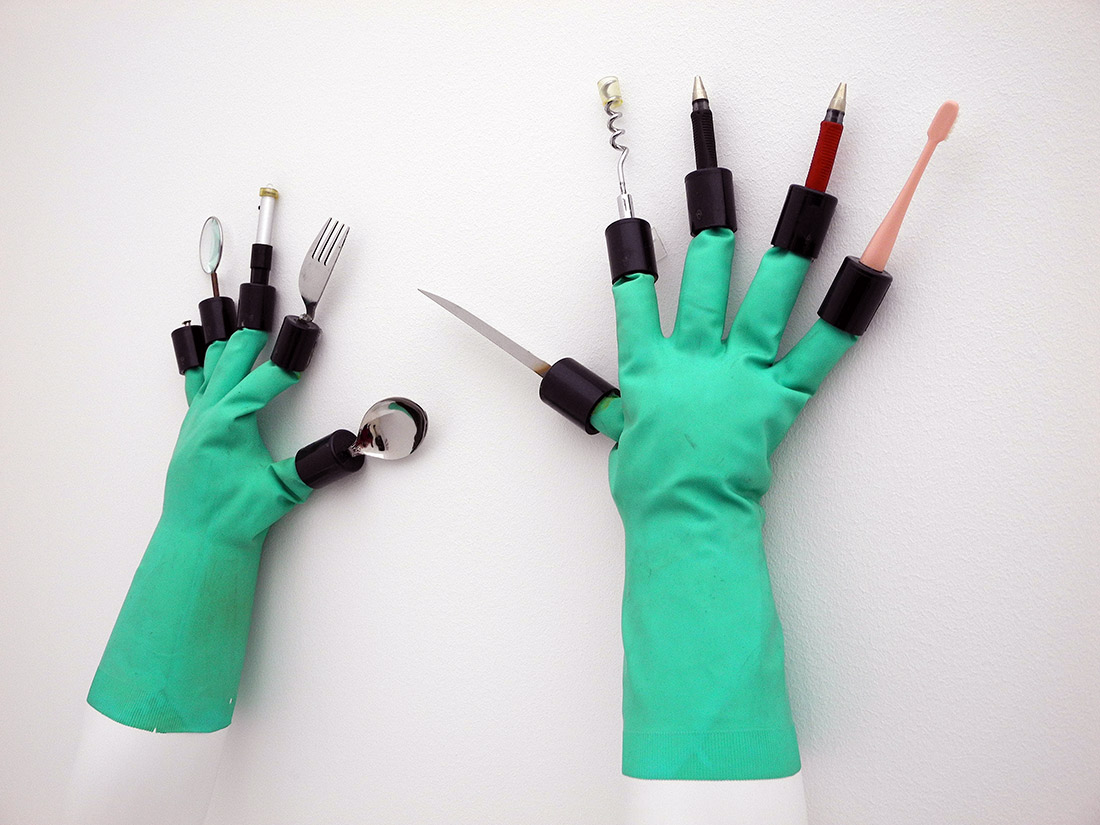
At this point, Kawakami is the only one carrying the chindogu torch. Clearly, he'll never stop inventing. But he can't go on forever. Someone will have to continue his work. The question is, should they?
Chindogu may have lofty ideals, but its popularity stems from stereotypes. They're not seen as merely "wacky inventions," but "wacky Japanese inventions." It's even in the title of the chindogu books. Chindogu's wackiness comes from Kenji Kawakami's personality, not his nationality. Unfortunately his ideas and philosophy get lost in the shuffle of marketing, and the "weird Japan" stereotype is perpetuated.
But it's his ideas, not the weirdness, that's worth preserving. Consider the words of Tim Moore from Idea Champions.
"It makes no difference whether the resulting invention is absurd, like Chindogu… The point is to keep exercising the mental muscle that crosses wires, tries absurd combinations, and associates the previously unassociated."
That's what creativity is all about. Seeing connections between things. Being bold enough to attempt those connections, even if the result is a little bit silly. It may not be the product you want, but it's the process you need.
